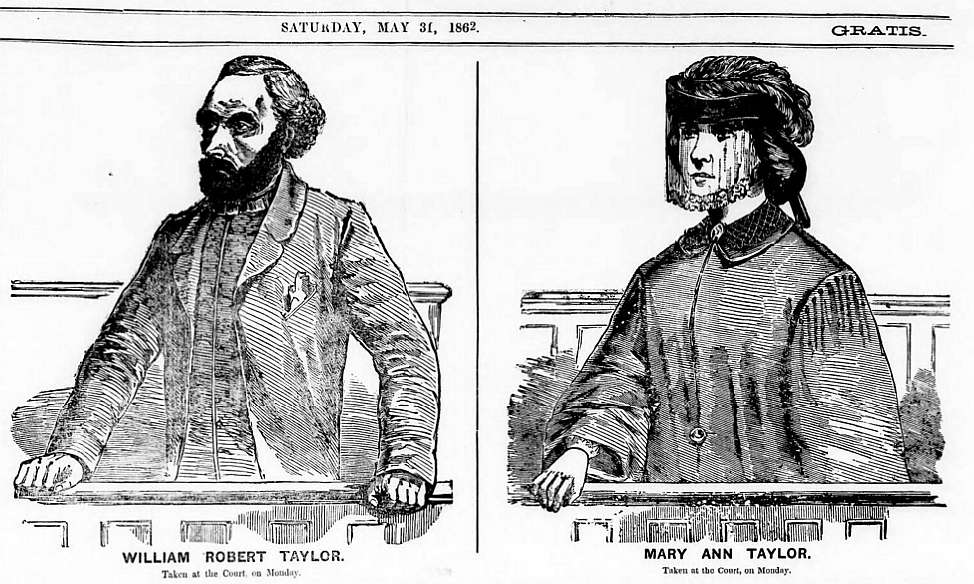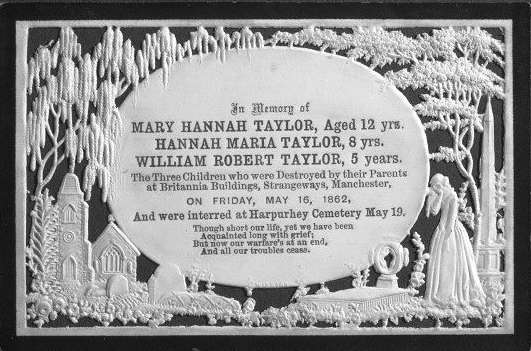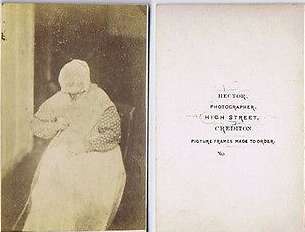William Robert Taylor - quadruple murderer, and the Hector family of Crediton.
William Robert Taylor was born in 1834 in Dunster, North Somerset where his father was a tea merchant. In 1849 he married Hannah Maria Farmer. He then worked as a school master in Huish Champflower, where the first of their four children was born. They later moved to Crediton where he worked for Badcock & co, wine and spirit merchants, as their senior clerk, living near the Star Inn at the East end of town. When Hannah his wife became ill, he took on 13 year old Mary Ann Hector as a servant. Shortly afterwards Hannah died in Crediton in November 1858, leaving him with the four children, all under eight years of age.
One night In January Taylor came home late, and, according to the girl Hector, “familiarities occurred” in the parlour. In August he suspected she was pregnant and wrote to a chemist to obtain “something that would set all to right”. A few days later Taylor gave her some powders and over the next few weeks gave her several more pills and potions. She then left his service and returned to her parents. She wrote to him, saying that there had been no result from what she had taken but the letter was intercepted by her brother.
As a result, on October 27th, 1859, "Taylor was taken before Sir H. Davie, Bart., and J. Sillifant, Esq., Crediton Magistrates, for examination, and so serious a charge brought against one who had to that time borne a fair reputation in the town, created a great deal of public excitement. At the request of his attorney (Mr. G. Turner), the case was heard privately. He was committed to trial at the Assizes on 14 December, charged with feloniously administering certain noxious or poisonous powders with intent to procure abortion."
Although Taylor did not deny that he was the father of her child, the jury found him not guilty, not being convinced that the substances he gave her were noxious.
The residents of Crediton were shocked; he sent his children to Dunster to be looked after by his parents and his sister. Taylor was sacked although it was several months before he moved out of Crediton, to Exeter, where he was given a similar job with Mr Hadley, spirit merchant, and Messrs Fraser and Thirkettle, tea merchants. He was a travelling salesman, paid by commission.
In due course Mary Ann Hector, now 15, gave birth to a baby daughter (Mary Louise) in Crediton and in May 1860 went to court and was awarded maintenance of two shillings a week from Taylor.
On one of his trips through Somerset Taylor met Martha Ann Giles, 21, of Hatherleigh Farm, Wincanton. Soon she moved in with him in Exeter where they lived as husband and wife in Paris Street, although they probably never were married. In 1861 he started to get into debt. They moved to Bideford where he started a business selling spirits but his financial problems worsened. He was accused of forging his father-in-law’s signature to get credit. The Taylors then disappeared with the children. One of his creditors pursued him to Manchester but never caught up with him.
In Manchester the Taylors rented a house: 5, Britannia Buildings, in Bury New Road. William Taylor complained several times to the landlord’s agent, 58-year old Evan Mellor, about the condition of the boiler in the kitchen.
On the evening of 19 January 1862, during very cold weather, the pipes froze and the boiler exploded. Taylor’s six year-old daughter Harriet Jane had been sitting in front of it and was struck by the grate, thrown across the kitchen and badly scalded. She was taken to Manchester Infirmary where she died in great pain the next day. At the inquest, where a verdict of “accidental death” was recorded, the jury severely censured Mr Mellor and his clerk for not taking Taylor’s complaints seriously.
Taylor got behind with his rent and Mellor sent the bailiffs in who removed all the furniture.
On Friday 16 May 1862, just after 9 a.m. William Taylor and his wife went to Mellor’s office in Lower King Street. They found his son there, and sat and waited for Evan Mellor to arrive. As soon as he came up the stairs Taylor attacked him and stabbed him eleven times with a ten inch butcher’s knife. He then attempted to shoot him in the head with a revolver. An ambulance took Mellor to the Infirmary where he was pronounced dead. Taylor said to the police “Thank God, my work is done.”
Taylor was taken to the police station. He handed over the keys to his house to the officers and told them that they would find something there. They found the house had been vandalised. In the bedroom, lying side by side on the floor, were the bodies of his three children. Their hair had been neatly brushed, and they had been “laid out” – each had a clean white shirt on, and there were black ribbons around their waists, necks and wrists. Each had a piece of paper on their chests: on one side were their names and ages, on the other was written “We are six, but one at Harptry lies: thither our bodies take. Mellor and son are our cruel murderers but God and our loving parents will avenge us. Love rules here we are all going to our sister to part no more”. On another bit of paper was written “Mellor our sister slew through gross neglect.”
Post mortem examinations of the children failed to establish a cause of death, although poisoning with chloroform was suspected.
William Taylor and his wife were both charged with murder and were tried on 21 August for the murder of Evan Mellor. They both pleaded “not guilty”, William Taylor stating “not a shadow of guilt”. His defence lawyer suggested that he suffered from insanity but the jury found him guilty. His wife was acquitted. He was sentenced to death and hanged at Kirkdale Prison in Liverpool on 13 September 1862.

The Taylors in court. (The legend should show Martha Ann rather than Mary Ann Taylor.)

Thousands of people attended when the three children were buried beside their sister’s grave in Manchester’s General (Harpurhey) Cemetery. A public subscription had raised £60 for a memorial stone.
Image © Victoria and Albert Museum, London.
Taylor's widow Martha returned to her father in Wincanton. In 1863 it was reported that she had briefly eloped with a 19 year old tailor’s apprentice, however on February 1 1864 in Wincanton she married William Davidge, a farm labourer whom she had known prior to going off with Taylor. Crowds of people booed and hissed at her as they left the church. They had a son (Charles William) in 1870, and the family moved back to her father’s farm. She died aged 66 in 1905.
The Hectors of Crediton.
Mary Ann Hector, whose child William Taylor fathered, was the daughter of William Hector and Jane Cann. William Hector (1820-1882) was a thatcher in Crediton but was also Crediton’s first commercial photographer. In about 1860 Mary Ann moved to London as a servant to the Pickett Family. (Richard Pickett was a tailor born in Sandford.) She married James Taylor, a bricklayer, in 1867. They had ten children. She died aged 63 in 1908 in Brentford, Middlesex.
Mary Ann’s first daughter (Mary Louise) was brought up by her grandparents in Crediton, where she died aged 15 in 1875.

The carte de visite by Hector (left) is almost certainly that of Mrs Christian Jeffery (sic) of Zeal Monachorum who died on 26 December 1868 aged almost 102.

